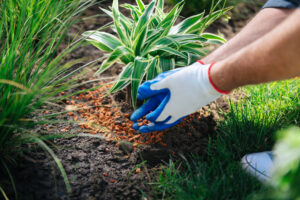
Editor’s Note: This article reprinted courtesy of SavATree. It originally appeared on the company blog. Learn more about SavATree under the About the Author section, below.
SavATree’s expert arborists advise to prepare your lawn, trees, and shrubs for an exceptionally hot summer. These tips will help you beat the heat.
What Will Those Hotter Temps Do to Your Landscape?
With the warmer weather, your property becomes an oasis to relax, play, and entertain. But that summer heat can also take its toll.
“Because high temperatures will hasten evaporation from your trees, shrubs, lawn, and soil” explains Patrick Parker, Plant Health Care Director for SavATree, “the delicate roots responsible for the uptake of soil moisture and nutrients can die.” And, Parker cautions, “Heat stress can allow more serious secondary conditions, such as insects or diseases, to proliferate, which can hasten the decline of plants under stress.”
Trained and certified arborists will:
-
- assess your trees, shrubs, and grass, and the soil they grow in, through laboratory soil tests and a visual inspection of your property
-
- identify the soil enhancements that will help your plants thrive during challenging summer conditions
-
- apply treatments to remedy deficiencies and discourage the disease and insect problems that heat stress can promote.
Organic Soil Enhancer: This treatment incorporates carbon-rich liquid organic matter designed to rebuild the organic profile of your soil. Resulting benefits include better water-holding capacity, improved nutrient retention and availability, increased beneficial microbial activity, and better soil structure.
Things You Can Do to Help Your Landscape Survive a Hot Summer
Don’t water during the middle of the day. When you water in the heat of the day, some of that moisture evaporates before it can reach the root systems. Instead, water early in the morning.
Better to water deeply, not daily. How often you should water your lawn and plants will depend on the weather conditions, the size of your plants, and your soil conditions. That said, here are general recommendations for good watering practices:
Lawns
Trees and shrubs
Mature trees require approximately 10 gallons of water for each inch of a tree’s diameter when the soil is dry, and newly-planted trees require much more water than established ones. In the summer, saturate the soil around the plant out to the “dripline” (an imaginary circle on the ground under the tips of the branches) about once a week. Drip irrigation is the preferred method as it prevents valuable water from being lost to evaporation and allows the plant to absorb the water at its own pace.
Mulch

-
- Lawn: There’s plenty of good water and nutrients in your grass clippings. Put that goodness back into the ground by mulching the clippings and leaving them on your lawn where they will sift down to the soil and decompose. It is recommended to leave a carpet of just one inch or less of mulched clippings to prevent smothering the grass.
-
- Trees and shrubs: To mitigate heat-related stress, place generous amounts of organic mulch — such as woodchips, shredded hardwood, or bark — around the base of the plants, starting two – six inches from the trunk and extending out to the dripline, to help the soil retain moisture. A thick layer (about two-four inches deep) is ideal.
Extreme temperatures can be dangerous and damaging to your grass and trees, but with a little proactive maintenance and a certified arborist, you can help them weather the weather this Summer.
ABOUT THE AUTHOR
SavATree was founded by Ralph Robbins in 1978 with a single objective in mind; to save trees from the devastating effects of repeated defoliations by the Gypsy Moth Caterpillar (Lymantria dispar). While this moth was accidentally introduced into the United States by French entomologist Leopold Trouvelot in 1868, it was not until the late 1970’s that the population exploded in the Northeast. Ralph, a graduate of Paul Smith’s college and entrepreneur at heart, saw an opportunity to make a difference in support of tree preservation and care. Over the years, SavATree has expanded throughout the country, and has added lawn care, deer deterrence, tick management and holiday lighting to its portfolio. Learn more by visiting www.savatree.com.

















